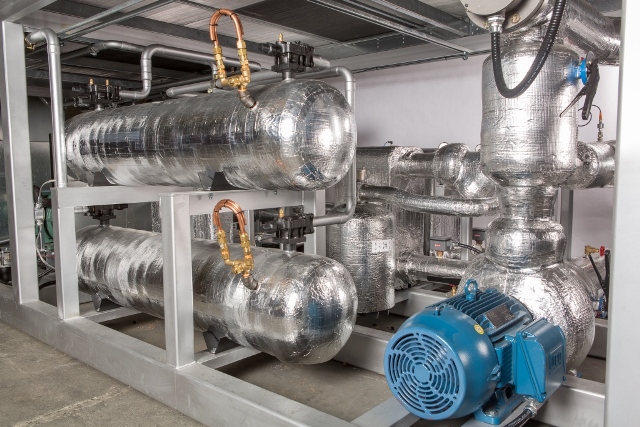Berg manufactures glycol chilling systems for a wide variety of industries ranging from food and beverage processing to
ice rinks. Yet, what makes these systems unique and how they operate remains a mystery to many of our current and potential clients.

Glycol chillers are industrial refrigeration systems that use a type of antifreeze called glycol, mixed with water, to lower the freezing point in the application of the chilling system. Here are the top three things you should know about glycol chillers.
Glycol and Your Chilling System Explained
Glycol is a class of organic compounds that belong to the alcohol family. When mixed with water and pumped through the pipes of a chilling system, glycol serves to slow the rate of freezing. It helps maintain temperature consistency in the application. Some glycol products also work to inhibit corrosion and bacterial growth within the pipes of the chilling system.
The Two Types of Glycol Compared
Glycol comes in two varieties that should never be mixed together: ethylene glycol and propylene glycol. Both types offer the same relative level of freeze protection. Both also help to guard against corrosion. Some grades of both types of glycol also help to prevent the growth of algae and bacteria within the chiller.
Ethylene Glycol
Ethylene glycol is a moderately toxic chemical that has a sweet taste and can be harmful if swallowed. For this reason, it should not be used in potable water or
food processing systems when leakage is a possibility.
Ethylene glycol has more widespread use due to its lower purchase price. Industrial applications like
ice rinks and
factories requiring large volumes of the coolant find this to be the most economical choice of glycol.
Propylene Glycol
Propylene glycol has a lower level of toxicity and is considered to be a food grade antifreeze. This type of glycol is safer to handle than ethylene and can be more easily disposed of.
Propylene glycol is commonly used in
food Industry or in industrial refrigeration systems where people may come into contact with fluid.
Propylene glycol can also become more viscous than ethylene, even slightly affecting the heat exchange rate when used at very low temperatures.
It is important to note that you should never mix different types or brand names of glycol, as this leads to the product congealing and the clogging of filters in the refrigeration system —potentially causing problems with heat transfer and fluid flow.
Mixing Water with Glycol in Your Industrial Refrigeration System
Although you should never mix glycol types there is something that should always be added: water. As mentioned, glycol must be mixed with water to function properly. The type and amount of water to use are key factors to consider.
Type of Water to Use
Each glycol chiller comes with its own set of manufacturer recommendations for the best type of water to use for that system. Although city water may be acceptable initially, it is almost never recommended that de-ionized water be maintained for the long term as it could have adverse affects on certain metals in the chiller. Sometimes manufactures require the chiller to use distilled or reverse-osmosis water. The key is to check with the manufacturer for the particular needs of your refrigeration system.
Read more about
how process water can affect a chilling system’s performance.
Ratio of Water to Glycol to Use
Calculating the proper ratio of glycol to water in your chilling system depends on the coldest temperature that the glycol solution will reach during operation. If a chilling system is used indoors where there is no chance of freezing, the amount of glycol needed would be significantly less than required by a glycol chiller used outdoors where temperatures are prone to drop below freezing.
Also, if an application requires a very low temperature to operate it should use a glycol mixture similar to that of an outdoor system.
In a chilling system, this temperature is normally the saturated suction temperature in the evaporator, and normally this temperature is 10°F below the chiller set point temperature.
Using the proper ratio of glycol and water in your chilling system is very important. Adding too much to your chiller system will cause it to become inefficient. However, not enough glycol could cause the system to freeze up, potentially bursting pipes or even rupturing the chiller evaporator.
Learn More About Glycol Chilling Systems
To learn more about how a glycol chiller works or to find out if this system is right for your application,
contact Berg Chilling Systems.
 Glycol chillers are industrial refrigeration systems that use a type of antifreeze called glycol, mixed with water, to lower the freezing point in the application of the chilling system. Here are the top three things you should know about glycol chillers.
Glycol chillers are industrial refrigeration systems that use a type of antifreeze called glycol, mixed with water, to lower the freezing point in the application of the chilling system. Here are the top three things you should know about glycol chillers.